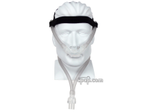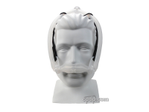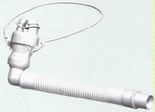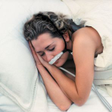- CPAP Masks
- CPAP Machines
- CPAP Supplies
- CPAP Accessories Home Sleep Test
- Blog
Chat with a 5-star expert now!
Chat with a 5-star expert now!
- Home /
- CPAP Masks /
- Other CPAP Masks /
- Nasal Prong
Nasal Prong CPAP Masks
Sort by 8 items
Filter by
Filter by
Clear

Nasal Aire II Prong CPAP Mask with Headgear


Nasal Aire II Petite Prong CPAP Mask with Headgear
Related Categories
About Nasal Prong CPAP Masks
Nasal prong masks are one type of CPAP mask that you can choose to alleviate your sleep apnea symptoms and support your nighttime breathing needs. Nasal prong CPAP masks deliver air directly into the nostrils. With two insertable prongs that inflate on entry, they offer a secure fit and have minimal facial coverage. Deciding whether or not a nasal prong CPAP mask is right for you depends upon your health, your sleep style, and your personal preferences.
What Is a Nasal Prong Mask?
A nasal prong CPAP mask has two prongs that fit directly inside your nostrils. CPAP nasal prongs inflate slightly to form a secure, pressurized seal. Nasal prong masks are fairly similar to nasal pillow masks. However, nasal prongs fit a little deeper inside the nose and create a seal with inflatable pressure. Conversely, nasal pillows form a seal by simply resting against the inner wall of the nostril. A nasal prong mask is fairly small and is held in place with compatible headgear.
If you're researching nasal prong CPAP masks, you may already be familiar with, or have worn previously, a cannula. A cannula is similar to a nasal prong CPAP mask. The cannula consists of a thin tube with two prongs that get inserted into each nostril. Air gets delivered via the tube and into the nostrils through each prong.
Benefits of a Nasal Prong CPAP Mask
There are several benefits that a nasal prong CPAP mask can provide:
- A Nasal Prong CPAP Mask Is Extremely Lightweight and Well-Suited to Anyone With Claustrophobia or a Dislike for Having Both Their Mouth and Nose Covered.
- Due to Inflation and Its Pressurized Seal, a Nasal Prong Mask Provides a Strong Fit for Those Who Move a Lot in Their Sleep.
- The CPAP Nasal Cannula Offers Evenly Distributed Pressure, Which Is More Comfortable for Anyone With a Deviated Septum or Who Otherwise Requires Less Septum Pressure.
- These Masks Have a Low Profile, so They Provide a Clear Line of Sight While You Wear Them.
- If You Have a Beard or Mustache, They Will Not Get in the Way of Your CPAP Mask.
Different Types of Nasal Prong Masks
You can differentiate nasal prong masks by their headgear styles. Some nasal prong CPAP masks come with headgear that travels around your forehead. This headgear style might be useful if you're a side sleeper. If you sleep on your back, you might enjoy a nasal prong CPAP mask with headgear that travels around the sides of your face.
There are also nasal prong CPAP masks that loop behind your ears and do not have any headgear at all. If you suffer from claustrophobia and do not like having anything restrictive on the head or face, this option may be the best choice.
Nasal Prong FAQs
What Are Nasal Prongs Used For?
Nasal prongs are used to deliver oxygen from the CPAP machine into your nose. Nasal prong CPAP masks use small, flexible tubes that are placed directly inside the nose. When the oxygen is delivered, the prongs inflate against the nostril walls to create a pressurized seal. They are lightweight, non-invasive, and ideal if you sleep on your back, side, or stomach. A nasal prong mask can also work well if you toss and turn in your sleep or suffer from claustrophobia.
How Do You Wear Nasal Prongs?
You place the nasal prongs, or cannulas, directly into your nose. They are held in place by headgear.
How Much Oxygen Do You Get From a Nasal Prong?
Nasal prong masks deliver four to six liters of oxygen.
What Is the Difference Between Nasal Prong Masks and Nasal Pillow CPAP Masks?
A nasal prong mask is smaller and more lightweight. A standard nasal prong mask measures approximately 1 1/2-inches tall and 1 1/2-inches wide. Comparatively, a full face mask can be as tall as five inches. The headgear for a nasal prong mask holds the prongs gently in place under your nose. Nasal prong masks, nasal pillow masks, and nasal masks work best if you are prone to breathing through your nose when you sleep. Full face masks fit over the mouth and nose and are more appropriate if you breathe through your mouth when you sleep or through both your mouth and nose. Full face masks also work well if you are someone who needs a higher pressure setting.
When Should I Switch From a Nasal Prong to a Full Face Mask?
If you find yourself struggling to breathe through your nose or if you need a higher flow of oxygen, you might want to consider switching. Nasal prong masks are not recommended for those who breathe through their mouth at night. Full face CPAP masks are indicated for those who breathe through their mouth when they sleep.
You're sure to breathe easier overnight when you have the right CPAP mask.
Customer HIghlights

Best In Comfort
I have used the Nasal Aire II for over 15 years. I have benefited from the ease of use and comfort. Other masks with nasal pillows come with a complicated system of straps that are claustrophobic and impossible to sort out in the middle of the night. Don't stop your therapy by using a product that you can't sleep with because your life depends on it.
Verified Purchase 2018-04-11

10+ Years With This Mask
I have been using the Nasal Aire II for over 10 years. It is comfortable to sleep in and does not block your vision. If you have a beard, this mask will not be as prone to leaking as other styles. Mine normally last a full 3 months before needing replacement. If you have never tried a nasal mask, it can take a while for your nose to stop hurting. Once you round that corner, it is great. I hope they never stop making this mask.
Verified Purchase 2019-08-27





